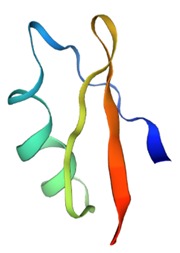OdK2
 OdK2 - Swiss-model | |
| Identifiers | |
|---|---|
| Class | Small Proteins |
| Superfamily | Scorpion toxin-like |
| Family | Scorpion short chain toxin, potassium channel inhibitor |
| Protein | P0C909 |
| Species | Odontobuthus doriae |
OdK2 is a toxin found in the venom of the Iranian scorpion Odonthobuthus doriae. It belongs to the α-KTx family, and selectively blocks the voltage-gated potassium channel Kv1.3 (KCNA3).
Etymology
[edit]Odonthobuthus doriae is a scorpion species that belongs to the Buthidae family, mainly found in central and southern Iran. OdK2 is an acronym indicating the toxins originating species, the type of ion channel it targets and the chronological order of its discovery.[1] OdK1 was the first toxin isolated from the same species’ venom, targeting the Kv1.2 channel (KCNA2).[2]
Chemistry
[edit]OdK2 is a relatively small peptide with 38 amino acids and a monoisotopic mass of 4079.869 Da (C167H278N54O49S8).[1]

According to the unified nomenclature for short-chain peptides isolated from scorpion venoms, Odk2 can be classified in the second α-KTx family, selectively blocking voltage-gated potassium channels.[3]
OdK2 is further classified as α-KTx 3.11 as it presents significant sequence homology with toxins from the α-KTx 3.x sub-family, especially Bs6, Agitoxin and Kaliotoxin.[1] This fact suggests that frequently observed structural motifs present on other toxins of the same subfamily, such as the α/β scaffold and the typical disulfide pairing, can be assumed for OdK2 as well.[1][4][5]
The presence of Lys27 and Phe25 residues, crucial for the α-KTx3-Kv1.3 interaction, is another highly conserved feature among α-KTx toxins.[5]
|
Gly-Val-Pro-Thr-Asp-Val-Lys-Cys-Arg-Gly-Ser-Pro-Gln-Cys-Ile-Gln-Pro-Cys-Lys-Asp-Ala-Gly-Met-Arg-Phe-Gly-Lys-Cys-Met-Asn-Gly-Lys-Cys-His-Cys-Thr-Pro-Lys |
|---|
Mode of action
[edit]OdK2 is one of the many Kv1.3 channel blockers found in the scorpion’s venom.[1] There is evidence suggesting that their binding mechanism to Kv1.3 is governed by electrostatic forces, exerted between specific amino acid residues in the toxins and in the pore regions of the channel’s subunits.[6] However, the precise OdK2 blocking mechanism remains unknown.[1]
Two prominent features of OdK2 are its blocking potency (IC50 value of 7.27 ± 2.7 nM) and its high selectivity for Kv1.3 channels, illustrated by 95% inhibition at a concentration of 35 nM, but no observed effect in other voltage-gated potassium channels. Amino acid residues only found in Kv1.3 pore regions and not in other Kv1.x channel family members, could potentially explain the high selectivity of OdK2.[1]
Kv1.3 channels are delayed rectifier channels. Their main function is to repolarize the membrane, counterbalancing the depolarizing effect of calcium influx. As the precise modulation of intracellular calcium concentration is critical for the cell's activation and proliferation, occlusion of the potassium channels has a strong effect on the cell’s calcium signaling pathway, indirectly disrupting its normal function.[7][8]
Toxicity
[edit]Observed effects of OdK2 infection include local pain, muscle paralysis and may lead to inflammation and necrosis.[1]
References
[edit]- ^ a b c d e f g h Abdel-Mottaleb Y, Vandendriessche T, Clynen E, Landuyt B, Jalali A, Vatanpour H, et al. (June 2008). "OdK2, a Kv1.3 channel-selective toxin from the venom of the Iranian scorpion Odonthobuthus doriae". Toxicon. 51 (8): 1424–30. doi:10.1016/j.toxicon.2008.03.027. PMID 18471844.
- ^ Abdel-Mottaleb Y, Clynen E, Jalali A, Bosmans F, Vatanpour H, Schoofs L, Tytgat J (November 2006). "The first potassium channel toxin from the venom of the Iranian scorpion Odonthobuthus doriae". FEBS Letters. 580 (26): 6254–8. doi:10.1016/j.febslet.2006.10.029. PMID 17070524. S2CID 41074581.
- ^ Tytgat J, Chandy KG, Garcia ML, Gutman GA, Martin-Eauclaire MF, van der Walt JJ, Possani LD (November 1999). "A unified nomenclature for short-chain peptides isolated from scorpion venoms: α-KTx molecular subfamilies". Trends in Pharmacological Sciences. 20 (11): 444–447. doi:10.1016/S0165-6147(99)01398-X. PMID 10542442.
- ^ Mouhat S, Jouirou B, Mosbah A, De Waard M, Sabatier JM (March 2004). "Diversity of folds in animal toxins acting on ion channels". The Biochemical Journal. 378 (Pt 3): 717–26. doi:10.1042/bj20031860. PMC 1224033. PMID 14674883.
- ^ a b Dauplais M, Lecoq A, Song J, Cotton J, Jamin N, Gilquin B, et al. (February 1997). "On the convergent evolution of animal toxins. Conservation of a diad of functional residues in potassium channel-blocking toxins with unrelated structures". The Journal of Biological Chemistry. 272 (7): 4302–9. doi:10.1074/jbc.272.7.4302. PMID 9020148. S2CID 31357809.
- ^ Yu K, Fu W, Liu H, Luo X, Chen KX, Ding J, et al. (June 2004). "Computational simulations of interactions of scorpion toxins with the voltage-gated potassium ion channel". Biophysical Journal. 86 (6): 3542–55. Bibcode:2004BpJ....86.3542Y. doi:10.1529/biophysj.103.039461. PMC 1304258. PMID 15189853.
- ^ Wulff H, Knaus HG, Pennington M, Chandy KG (July 2004). "K+ channel expression during B cell differentiation: implications for immunomodulation and autoimmunity". Journal of Immunology. 173 (2): 776–86. doi:10.4049/jimmunol.173.2.776. PMID 15240664. S2CID 13521697.
- ^ Chandy KG, Wulff H, Beeton C, Pennington M, Gutman GA, Cahalan MD (May 2004). "K+ channels as targets for specific immunomodulation". Trends in Pharmacological Sciences. 25 (5): 280–9. doi:10.1016/j.tips.2004.03.010. PMC 2749963. PMID 15120495.
